Morphological Analysis of a New Species of Micropterus (Teleostei: Centrarchidae) from Lake Erie, PA, USA
Abstract
Simple Summary
Abstract
1. Introduction
2. Materials and Methods
3. Results
3.1. Holotype
3.2. Diagnosis
3.3. Description
3.4. Etymology
3.5. Distribution
3.6. Remarks
4. Discussion
5. Conclusions
Author Contributions
Funding
Institutional Review Board Statement
Informed Consent Statement
Data Availability Statement
Acknowledgments
Conflicts of Interest
References
- Ruffing, R.A.; Kocovsky, R.M.; Stauffer, J.R., Jr. An introduction to species concepts and speciation of fishes. Fish Fish. 2002, 3, 143–145. [Google Scholar] [CrossRef]
- Dierickx, K.; Snoeks, J. Protomelas krampus, a new paedophagous cichlid from Lake Malawi (Teleostei, Cichlidae). European J. Taxonomy. 2020, 672, 1–18. [Google Scholar] [CrossRef]
- Pauers, M.J.; Phiri, T.B. Six new species of Labeotropheus (Cichliformes: Cichlidae) from the Malawian shore of Lake Malawi, Africa. Ichtyology Herpetol. 2023, 2023, 264–292. [Google Scholar] [CrossRef]
- Mayr, E.; Provine, W.B. The Evolutionary Synthesis: Perspectives on the Unification of Biology; Harvard University Press: Cambridge, MA, USA, 1980. [Google Scholar]
- Davis, J.I. Phylogenetic, molecular variation, and species concepts. Bioscience 1996, 46, 502–511. [Google Scholar] [CrossRef][Green Version]
- Stauffer, J.R., Jr.; Criswell, R.W.; Fischer, D.P. The Fishes of Pennsylvania; Cichlid Press: El Paso, TX, USA, 2016; 556p. [Google Scholar]
- Bailey, R.M. A Systematic Revision of the Centrarchid Fishes, with a Discussion of Their Distribution, Variation, and Probable Interrelationships. Ph.D. Dissertation, University of Michigan, Ann Arbor, MI, USA, 1938. [Google Scholar]
- Roberts, F.L. A chromosome study of twenty species of Centrarchidae. J. Morph. 1964, 115, 401–418. [Google Scholar] [CrossRef]
- Kim, D.; Taylor, A.T.; Near, R.J. Phylogenomics and species delimitation of the economically important Black Basses (Micropterus). Sci. Rep. 2022, 12, 9–14. [Google Scholar] [CrossRef]
- Lee, D.S.; Gilbert, C.R.; Hocutt, C.H.; Jenkins, R.E.; McAllister, D.E.; Stauffer, J.R., Jr. Atlas of North American Freshwater Fishes; North Carolina State Museum of Natural History: Raleigh, NC, USA, 1980; 867p. [Google Scholar]
- Jenkins, R.E.; Burkhead, N.M. Freshwater Fishes of Virginia; American Fisheries Society: Bethesda, MD, USA, 1994; 1080p. [Google Scholar]
- Loyacano, H.A., Jr.; Chappell, J.A.; Gauthreaux, S.A. Sun-compass orientation in juvenile largemouth bass, Micropterus salmoides. Trans. Am. Fish. Soc. 1977, 106, 77–79. [Google Scholar] [CrossRef]
- Messing, C.L.; Wicker, A.M. Home range, spawning migrations, and homing of radio-tagged Florida largemouth bass in two central Florida lakes. Trans. Am. Fish. Soc. 1986, 115, 286–295. [Google Scholar] [CrossRef]
- Smith, S.M.; Orth, D.J. Abundance and trophic ecology of largemouth bass in relation to submerged aquatic vegetation in a reservoir. Virginia J. Sci. 1987, 38, 125. [Google Scholar]
- Paukert, C.P.; Willis, D.W. Population characteristics and ecological role of northern pike in shallow natural lakes in Nebraska. N. Am. J. Fish. Manag. 2004, 23, 313–322. [Google Scholar] [CrossRef]
- Savitz, J. Trophic diversity and food partitioning among fishes associated with aquatic macrophyte patches. Trans. State Acad. Sci. 1981, 74, 111–120. [Google Scholar]
- Savino, J.F.; Stein, R.A. Behavior of fish predators and their prey: Habitat choice between open water and dense vegetation. Envir. Bio. Fishes 1989, 24, 287–293. [Google Scholar] [CrossRef]
- Page, L.M.; Burr, B.M. A Field Guide to Freshwater Fishes of North America North of Mexico; Houghton Mifflin Harcourt: Goston, MA, USA, 1991. [Google Scholar]
- Trautman, J.B. The Fishes of Ohio; revised ed.; Ohio State University Press: Columbus, OH, USA, 1981. [Google Scholar]
- Robins, W.H.; MacCrimmon, H.R. The Black Bass in America and Overseas; Bio-management and Research Enterprises: Sault Sainte Marie, ON, Canada, 1974; 196p. [Google Scholar]
- Layher, W.G.; Maughan, O.E. Spotted bass habitat suitability related to fish occurrence and biomass and measures of physiochemical variables. N. Am. J. Fish. Man. 1987, 7, 238–251. [Google Scholar] [CrossRef]
- Kelso, W.E. Trophic Overlap and Competition among Juvenile Littoral Fishes in Claytor Lake; Polytechnic Institute and State University: Virginia, VA, USA, 1983; 322p. [Google Scholar]
- Schultz, K. Ken Schultz’s Field Guide to Freshwater Fish; John Wiley & Sons: Hoboken, NJ, USA, 2003; 272p. [Google Scholar]
- Baker, W.H.; Johnston, C.E.; Folkerts, G.W. The Alabama Bass, Microterus henshalli (Teleostei: Centrarchidae), from the Mobile River Basin. Zootaxa 2008, 1861, 57–67. [Google Scholar] [CrossRef]
- Konings, A.; Stauffer, J.R., Jr. Revised diagnosis of Metriaclima (Teleostei: Cichlidae) with description of a new species from Lake Malaŵi National Park, Africa. Ichthy. Expl. Fresh. 2006, 17, 233–246. [Google Scholar]
- Humphries, J.M.; Bookstein, F.L.; Chernoff, B.; Smith, G.R.; Elder, R.L.; Poss, S.G. Multivariate discrimination by shape in relation to size. Syst. Zool. 1981, 30, 291–308. [Google Scholar] [CrossRef]
- Stauffer, J.R., Jr.; Bowers, N.J.; Kellogg, K.A.; McKaye, K.R. A revision of the blue-black Pseudotropheus zebra (Teleostei: Cichlidae) complex from Lake Malawi, Africa, with a description of a new genus and ten new species. Proc. Acad. Nat. Sci. Phila. 1997, 148, 189–230. [Google Scholar]
- Baker, W.; Blanton, R.E.; Johnston, C.E. Diversity within the Redeye Bass, Micropterus coosae (Perciformes: Cnentrarchidae) species group, with descriptions of four new species. Zootaxa 2013, 3635, L379–L401. [Google Scholar] [CrossRef]
- Williams, J.D.; Burgess, G.H. A new species of bass, Micropterus cataractae Teleostei: Centrarchidae), from the Apalachicola River Basin in Alabama, Florida, and Georgia. Bull. Fla. Mus. Nat. Hist. 1999, 42, 81–114. [Google Scholar] [CrossRef]
- Hubbs, C.L.; Bailey, R.M. A Revision of the Black Basses (Micropterus and Huro) with Description of Four New Forms; Miscellaneous Publications, Museum of Zoology, University of Michigan: Ann Arbor, MI, USA, 1940; Volume 48, pp. 7–51. [Google Scholar]
- Bailey, R.M.; Hubbs, C.L. The black basses (Micropterus) of Florida with description of a new species. Occas. Pap. Mus. Zool. 1949, 516, 1–40. [Google Scholar]
- Stauffer, J.R., Jr.; Kocovsky, P.M.; Ruffing, R.A. Species concepts and speciation of fishes: Concluding remarks. Fish Fish. 2002, 2002, 230–232. [Google Scholar] [CrossRef]
- Eldridge, N. Species selection, and Patterson’s concept of the specific-mate recognition system. In Speciation and the Recognition Concept; Lambert, D.M., Spencer, H.G., Eds.; The Johns Hopkins University Press: Baltimore, MD, USA, 1995. [Google Scholar]
- Mayden, R. A hierarchy of species concepts: The denouement of the species problem. In The Units of Biodiversity–Species in Practice; Special Voluem 54, Claridge, M.F., Dawah, H.A., Wilson, M.R., Eds.; Systematics Association: Reading, UK, 1997. [Google Scholar]
- Nelson, J.S. Editorial and introduction: The species concept in fish biology. Rev. Fish Biol. Fish. 1999, 9, 277–280. [Google Scholar] [CrossRef]
- Simpson, G.G. The species concept. Evolution 1951, 5, 285–298. [Google Scholar] [CrossRef]
- Wiley, E.O. The evolutionary species concept reconsidered. Syst. Zoo. 1978, 27, 227–244. [Google Scholar] [CrossRef]
- Mayr, E.; Ashlock, P.D. Principles of Systematic Zoology; McGraw-Hill Inc.: New York, NY, USA, 1991. [Google Scholar]
- Ghiselin, M.T. Species concepts: The basis for controversy and reconciliation. Fish Fish. 2002, 3, 151–160. [Google Scholar] [CrossRef]
- Barlow, G.W. How behavioral studies contribute to the species problem: A piscine perspective. Fish Fish. 2002, 3, 197–212. [Google Scholar] [CrossRef]
- Mayden, R. On biological species, species concepts and individuation in the natural world. Fish Fish. 2002, 3, 171–196. [Google Scholar] [CrossRef]
- Stiassny, M.L.J. Phylogenetic intrarelationships of the family Cichlidae: An overview. In Cichlid Fishes: Behaviour, Ecology, and Evolution; Keenleyside, M.H.A., Ed.; Chapman &Hall: New York, NY, USA, 1991. [Google Scholar]
- Reyment, R.; Blackith, R.; Cambell, N. Multivariate Morphometrics; Academic Press: Cambridge, MA, USA, 1984. [Google Scholar]
- Stauffer, J.R., Jr.; McKaye, K.R.; Konings, A.F. Behaviour: An important diagnostic tool for Lake Malawi cichlids. Fish Fish. 2002, 3, 213–224. [Google Scholar] [CrossRef]
- Cracraft, J. Species concepts and speciation analysis. Curr. Ornithol. 1983, 1, 159–187. [Google Scholar]
- Cracraft, J. Speciation and its ontology: The empirical consequences of alternative species concepts for understanding patterns and processes of differentiation. In Speciation and Its Consequences; Otte, D., Endler, J.A., Eds.; Sinauer Associates: Sunderland, MA, USA, 1989; pp. 28–59. [Google Scholar]
- Platnick, N.I. Review of concepts of species by, C.N. Slobodchkoff. Syst. Zoo. 1977, 26, 96–98. [Google Scholar] [CrossRef]
- Rosen, D.E. Vicariant patterns and historical explanation in biogeography. Syst. Zoo. 1978, 27, 159–188. [Google Scholar] [CrossRef]
- Cracraft, J. Species concepts and speciation analysis. In The Units of Evolution: Essays on the Nature of Specis; Ereshefsky, M., Ed.; The MIT Press: Cambridge, MA, USA, 1992; pp. 93–120. [Google Scholar]
- Godbout, J.D.; Aday, D.D.; Rice, J.A.; Bangs, M.R.; Quattro, J.M. Morphological models for identifying largemouth bass, spotted bass, and largemouth × spotted bass hybrids. N. Am. J. Fish. Mgt. 2009, 29, 1425–1437. [Google Scholar] [CrossRef]
- Branson, B.A.; Moore, G.A. The lateralis component of the acoustic-lateralis system in the sunfish family Centrarchidae. Copeia 1962, 1962, 1–108. [Google Scholar] [CrossRef]
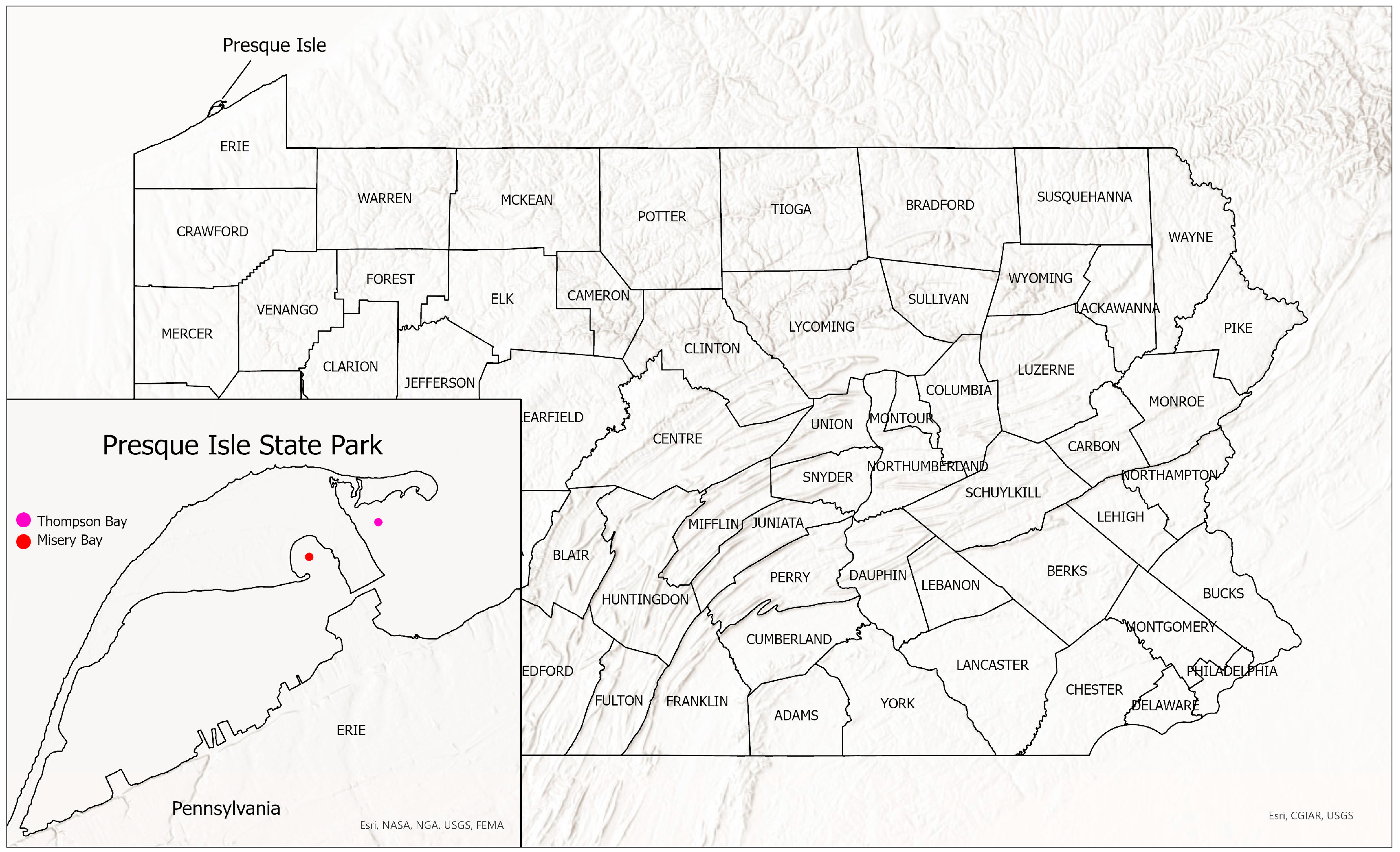
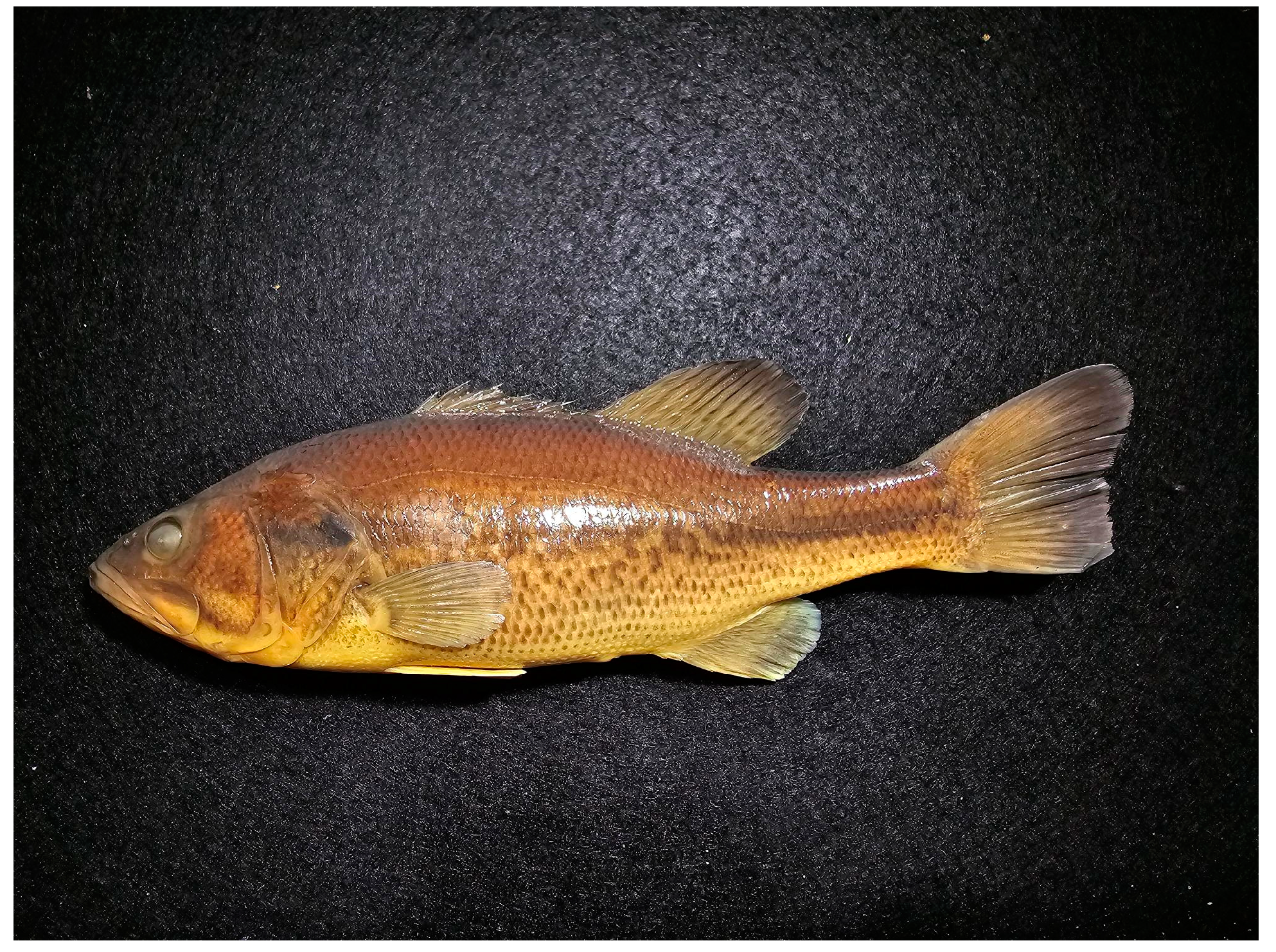
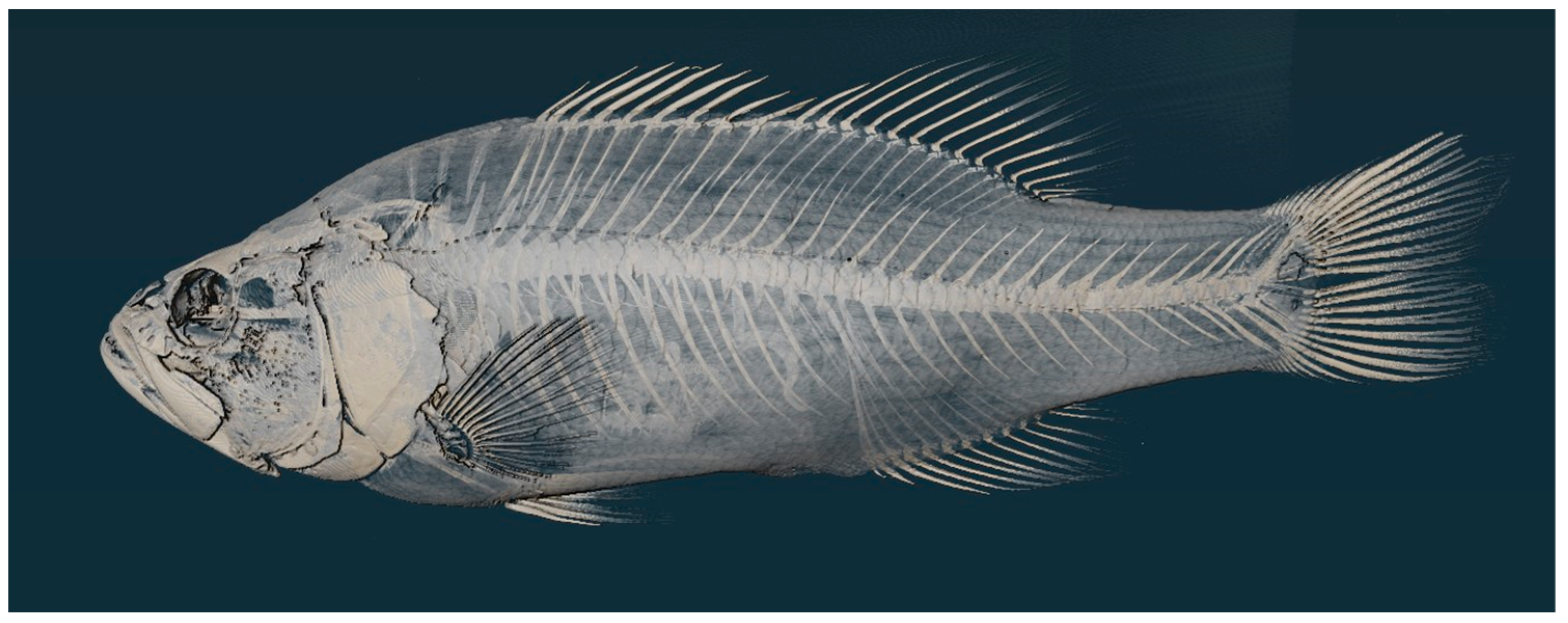
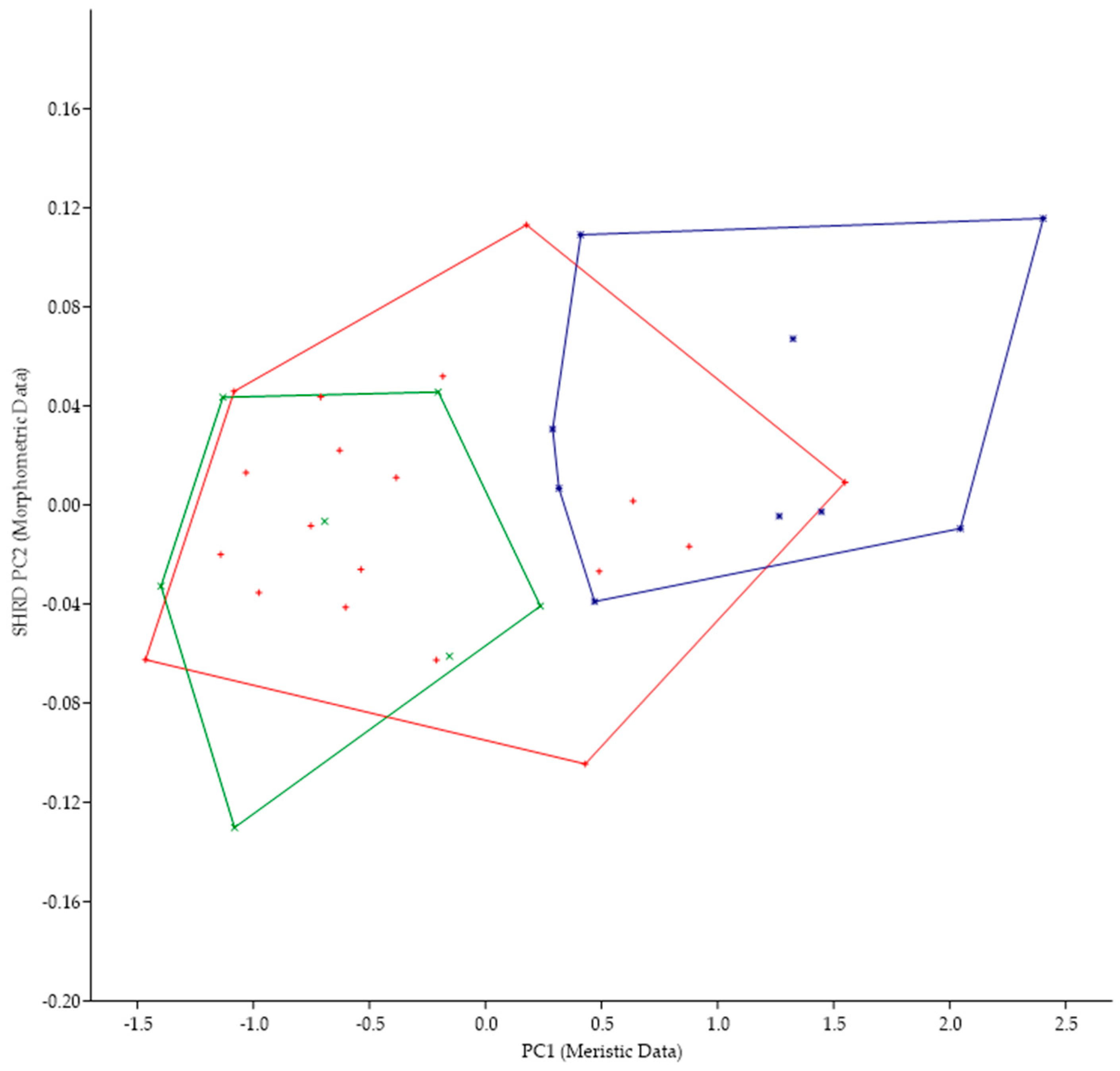
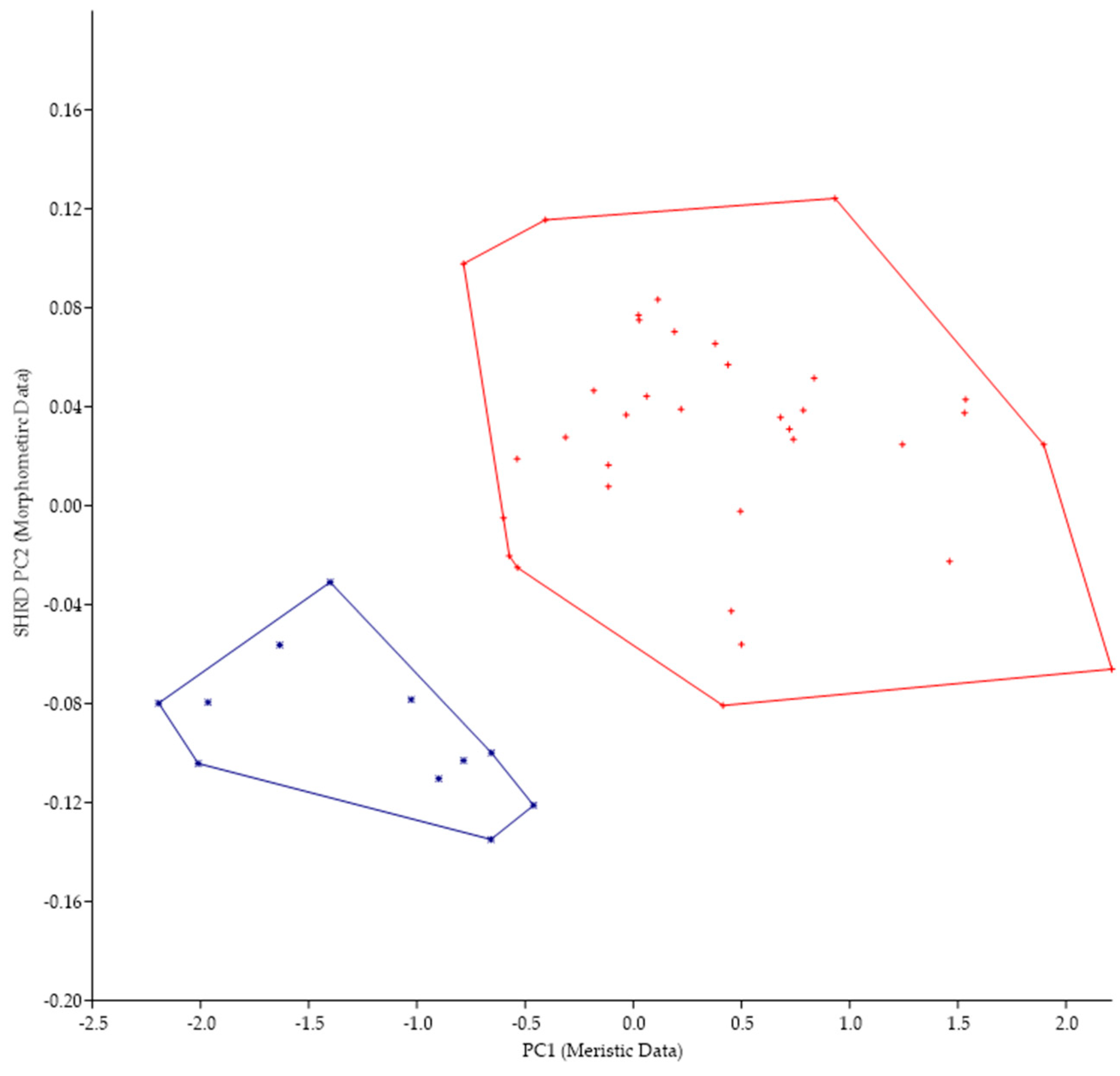
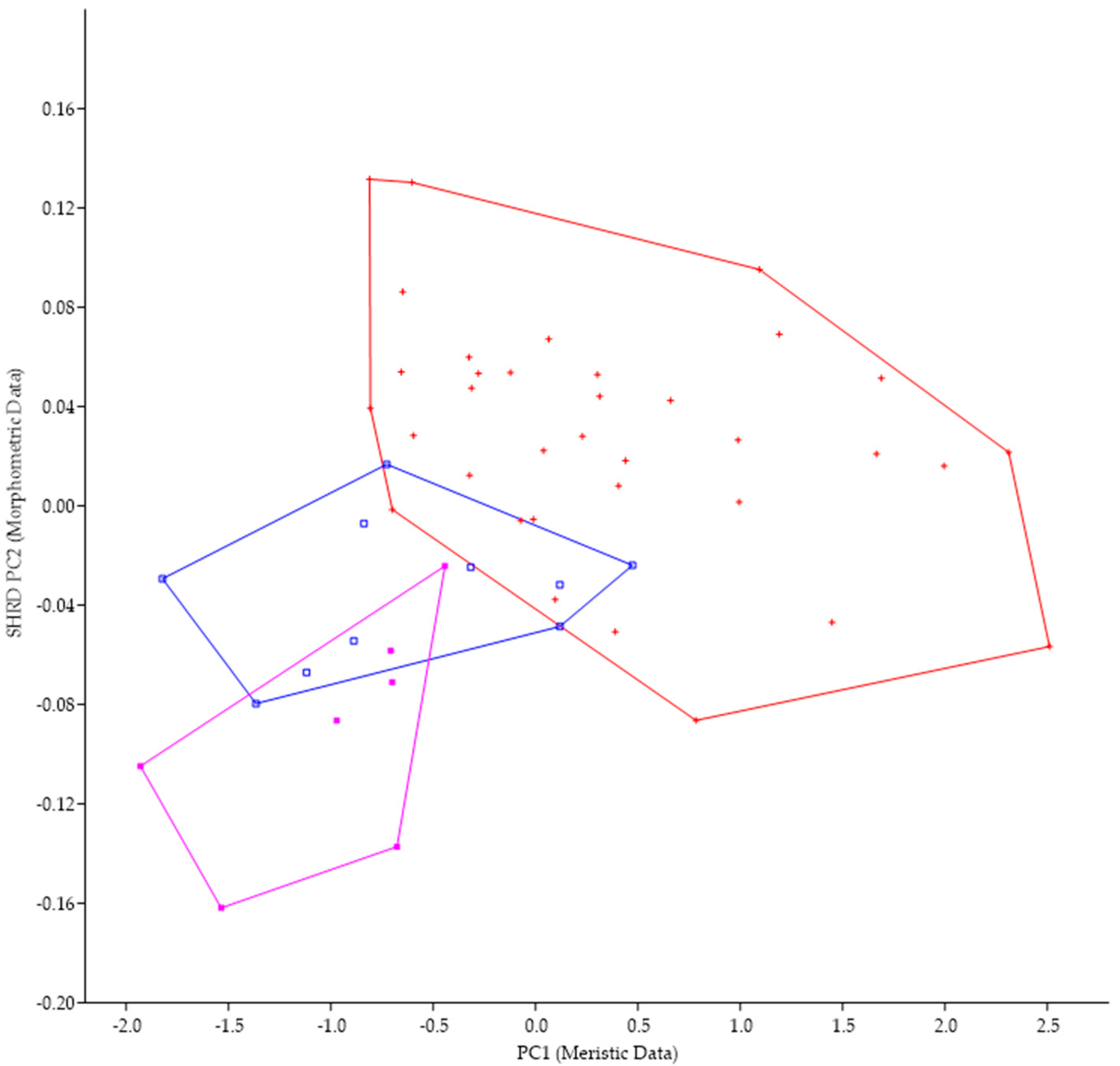
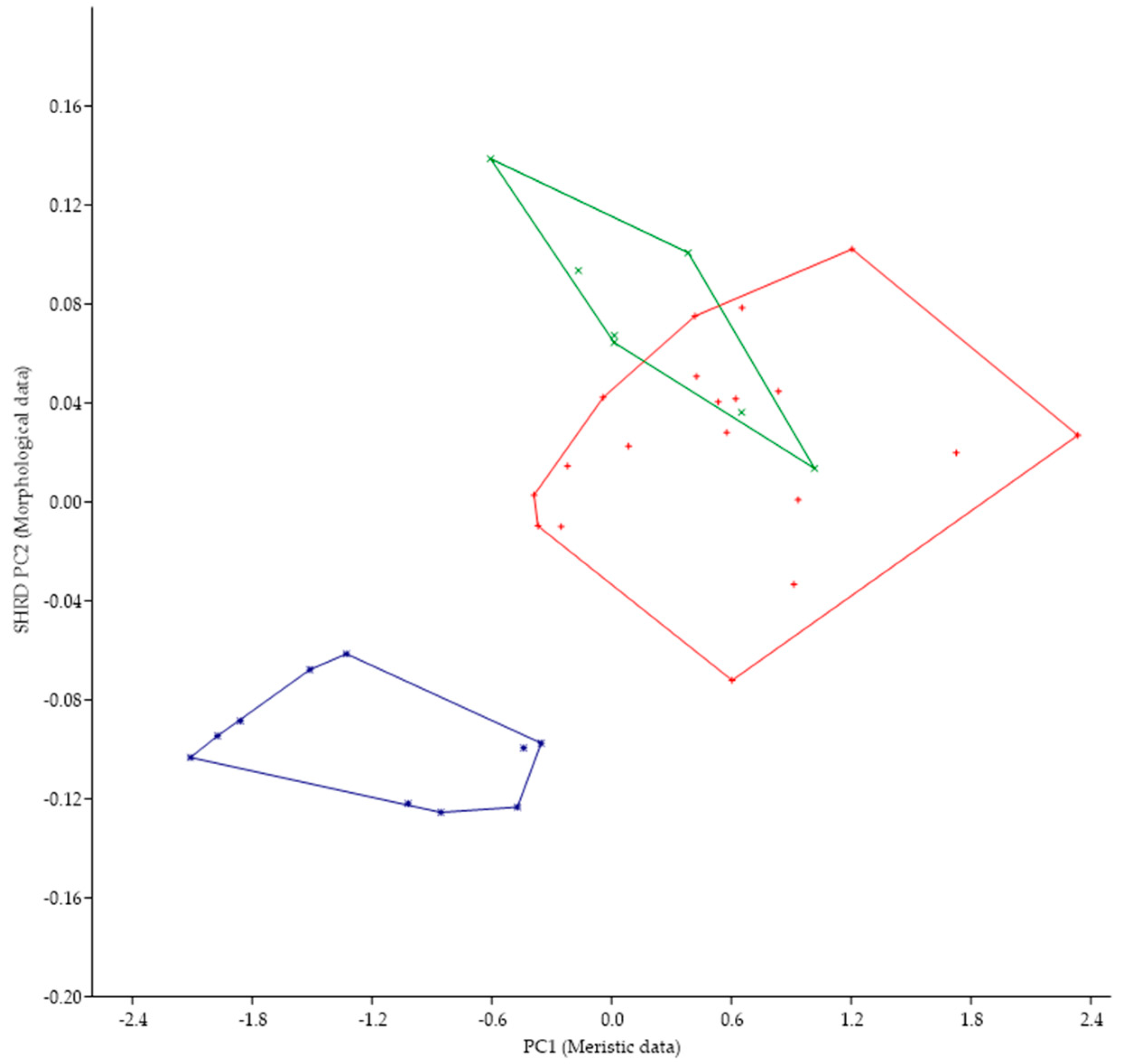
| Variable | Holotype | Thompson Bay (7) | Misery Bay (19) | ||||
|---|---|---|---|---|---|---|---|
| Mean | SD | Range | Mean | SD | Range | ||
| Standard Length, mm | 190.9 | 206.8 | 33.5 | 166.1–270.3 | 169.4 | 85.4 | 76.1–321.6 |
| Head Length | 66.7 | 72.3 | 12.1 | 64.2–94 | 59.7 | 31.4 | 27.7–111.0 |
| Percent Head Length | |||||||
| Snout Length | 17.9 | 20.0 | 2.9 | 17.9–24.9 | 16.5 | 8.7 | 7.4–29.6 |
| Post-Orbital Head Length | 53.5 | 59.6 | 10.7 | 53.5–79 | 48.9 | 25.7 | 20.9–94.7 |
| Horizontal Eye Diameter | 11.4 | 11.4 | 1.8 | 10.9–14.5 | 10.1 | 3.9 | 6.1–17.3 |
| Vertical Eye Diameter | 9.8 | 9.9 | 1.9 | 9.4–13.4 | 9.1 | 3.5 | 5–15.2 |
| Premaxillary Bone Length | 29.9 | 32.5 | 6.3 | 29.7–43.8 | 29.2 | 16.1 | 11.9–57.6 |
| Lower Jaw Length | 35.2 | 35.1 | 6.3 | 32.3–46.8 | 31.1 | 17.2 | 13.3–61.6 |
| Head Depth | 33.6 | 30.0 | 5.7 | 25.4–35.4 | 23.0 | 11.4 | 10.4–40.3 |
| Interorbital Width | 18.0 | 18.8 | 3.0 | 15.9–23.7 | 15.8 | 8.4 | 6.7–28.8 |
| Percent Standard Length | |||||||
| Snout to Dorsal Fin Length | 78.0 | 84.1 | 13.5 | 76.7–108.5 | 70.9 | 36.3 | 30.8–132.3 |
| Snout to Pelvic Fin Length | 67.2 | 71.2 | 10.8 | 64.3–91 | 58.5 | 30.2 | 24.3–111.3 |
| 1st Dorsal Fin Base Length | 41.1 | 43.9 | 7.8 | 38.1–57.5 | 36.2 | 17.7 | 13.8–63.1 |
| 2nd Dorsal Fin Base Length | 40.0 | 42.1 | 6.6 | 39.4–53.6 | 34.5 | 16.7 | 16.1–57.8 |
| Ant. Dorsal to Ant. Anal | 57.2 | 59.4 | 7.7 | 54.7–73.5 | 50.1 | 25.9 | 21.2–85.3 |
| Ant. Dorsal to Post. Anal | 61.9 | 64.5 | 9.6 | 60.1–82.3 | 54.0 | 26.8 | 23.4–89.9 |
| Post. Dorsal to Ant. Anal | 50.5 | 53.3 | 6.8 | 47.3–64.6 | 43.9 | 22.4 | 17.3–74.4 |
| Post. Dorsal to Post. Anal | 32.2 | 33.4 | 4.8 | 30–42 | 27.4 | 14.6 | 10.4–46.5 |
| Post. Dorsal to Vent. Caudal | 46.8 | 53.5 | 11.5 | 46.8–74.2 | 44.0 | 21.7 | 18.7–71.2 |
| Post. Anal to Dorsal Caudal | 46.0 | 57.0 | 13.5 | 46–72.1 | 42.1 | 21.1 | 18.4–71.4 |
| Ant. Dorsal to Post. Peduncle | 84.0 | 93.6 | 15.8 | 84–122.4 | 76.7 | 36.3 | 35–131.5 |
| Post. Dorsal to Post. Peduncle | 46.6 | 52.6 | 9.0 | 46.6–68.3 | 42.0 | 20.2 | 19.3–68.6 |
| Caudal Peduncle Length | 36.1 | 39.9 | 8.3 | 36.1–55.6 | 33.8 | 16.4 | 15–59.2 |
| Least Caudal Peduncle Length | 24.9 | 24.6 | 3.1 | 22.8–30.6 | 20.7 | 10.9 | 8.3–35.2 |
| Meristics | Mode | %Freq | Range | Mode | %Freq | Range | |
| Dorsal Spines | 10.0 | 10 | 100 | 10.0 | 94.7 | 9–10 | |
| Dorsal Rays | 13 | 13 | 85.7 | 12–13 | 11 | 57.8 | 11–13 |
| Anal Spines | 3 | 3 | 100 | 3 | 100 | ||
| Anal Rays | 11 | 11 | 85.7 | 11–12 | 11 | 63.2 | 10–12 |
| Lateral Line Scales | 62 | 61/63 | 28.6 | 57–65 | 60–64 | 15.8 | 58–67 |
| Cheek Row Scales | 1 | 1 | 85.7 | 1–2 | 1 | 100 | |
| Preoperculum Scale Rows | 6 | 6 | 42.9 | 3–7 | 7 | 36.8 | 5–10 |
| Operculum Scale Rows | 7 | 4–6 | 26.7 | 4–7 | 6 | 47.4 | 5–8 |
| Variable | |||
|---|---|---|---|
| Mean | SD | Range | |
| Standard Length, mm | 260.4 | 37.5 | 208–307 |
| Head Length | 92.8 | 15.1 | 73.8–116.7 |
| Percent Head Length | 21–31.3 | ||
| Snout Length | 25.9 | 3.4 | 59.7–92.9 |
| Post-Orbital Head Length | 76.5 | 12.6 | 11.3–17 |
| Horizontal Eye Diameter | 13.8 | 1.8 | 10.4–15.8 |
| Vertical Eye Diameter | 12.9 | 1.8 | 35.5–58 |
| Premaxillary Bone Length | 44.6 | 7.4 | 37.5–60.4 |
| Lower Jaw Length | 48.2 | 8.3 | 29.3–47.4 |
| Head Depth | 38.5 | 6.2 | 20.2–31.2 |
| Interorbital Width | 25.5 | 3.9 | 21–31.3 |
| Percent Standard Length | |||
| Snout to Dorsal Fin Length | 108.4 | 16.2 | 87–128.8 |
| Snout to Pelvic Fin Length | 90.7 | 13.2 | 72.9–109.1 |
| 1st Dorsal Fin Base Length | 56.9 | 10.6 | 45–75.4 |
| 2nd Dorsal Fin Base Length | 53.7 | 7.3 | 44–62.1 |
| Ant. Dorsal to Ant. Anal | 83.8 | 11.7 | 68.4–99.2 |
| Ant. Dorsal to Post. Anal | 84.8 | 11.2 | 68.6–98.4 |
| Post. Dorsal to Ant. Anal | 73.3 | 11.0 | 58.6–87 |
| Post. Dorsal to Post. Anal | 45.1 | 7.5 | 35.6–55.4 |
| Post. Dorsal to Vent. Caudal | 66.4 | 9.9 | 53.7–80.2 |
| Post. Anal to Dorsal Caudal | 66.7 | 9.2 | 52.7–75.7 |
| Ant. Dorsal to Post. Peduncle | 113.8 | 17.1 | 92.3–135.8 |
| Post. Dorsal to Post. Peduncle | 61.8 | 8.7 | 51.4–74 |
| Caudal Peduncle Length | 46.6 | 8.0 | 37.4–58.6 |
| Least Caudal Peduncle Length | 34.4 | 4.6 | 28–40.7 |
| Meristics | Mode | %Freq | Range |
| Dorsal Spines | 10 | 100 | |
| Dorsal Rays | 13 | 77.8 | 12–13 |
| Anal Spines | 3 | 100 | |
| Anal Rays | 12 | 55.6 | 11–12 |
| Lateral Line Scales | 63 | 33.3 | 59–65 |
| Cheek Row Scales | 2 | 100 | |
| Preoperculum Scale Rows | 8 | 33 | 6–10 |
| Operculum Scale Rows | 6/8 | 33.3 | 5–8 |
| Micropterus punctulatus | Micropterus nigricans(Allegheny) | Micropterus nigricans (Sus.) | |||||||
|---|---|---|---|---|---|---|---|---|---|
| Variable | Mean | SD | Range | Mean | SD | Range | Mean | SD | Range |
| Standard Length, mm | 94.7 | 26.8 | 70.9–157.3 | 120.7 | 31.7 | 78.4–157.8 | 162.3 | 42.6 | 121.8–264.1 |
| Head Length | 31.0 | 7.3 | 24.4–42.4 | 42.8 | 10.8 | 28.5–55.4 | 56.0 | 14.9 | 42.4–92 |
| Percent Head Length | |||||||||
| Snout Length | 29.5 | 1.1 | 27.4–30.7 | 27.5 | 2.0 | 24.9–31 | 27.7 | 1.5 | 26–30.8 |
| Post-Orbital Head Length | 82.4 | 5.4 | 75.6–91.4 | 78.5 | 3.4 | 73.2–84.3 | 85.3 | 4.3 | 76.9–90 |
| Horizontal Eye Diameter | 24.3 | 2.1 | 20.9–27.7 | 18.8 | 1.9 | 16.7–21.3 | 17.6 | 1.7 | 15.8–21.6 |
| Vertical Eye Diameter | 22.7 | 1.9 | 19.9–26.1 | 17.5 | 2.3 | 14.4–21 | 15.8 | 1.8 | 13.3–18.8 |
| Premaxillary Bone Length | 1.4 | 0.3 | 1.1–1.9 | 2.0 | 0.5 | 1.2–2.7 | 2.6 | 0.6 | 2.1–4 |
| Lower Jaw Length | 45.2 | 3.0 | 39.4–48.6 | 53.0 | 3.9 | 49–61.2 | 50.5 | 2.5 | 45.7–54.6 |
| Head Depth | 37.9 | 4.5 | 30.8–34.1 | 32.5 | 3.5 | 28.0–37.1 | 39.1 | 1.9 | 36.3–42.6 |
| Interorbital Width | 7.7 | 0.7 | 6.2–9.1 | 8.1 | 1.7 | 7.9–8.3 | 9.2 | 0.4 | 8.5–9.6 |
| Percent Standard Length | |||||||||
| Snout to Dorsal Fin Length | 41.7 | 3.1 | 33.2–44.1 | 41.6 | 1.2 | 40.6–44.2 | 42.1 | 1.0 | 40.8–43.8 |
| Snout to Pelvic Fin Length | 31.7 | 2.9 | 24.2–34.7 | 35.4 | 1.4 | 33.3–37.4 | 33.5 | 0.9 | 32.3–35.6 |
| 1st Dorsal Fin Base Length | 20.8 | 1.9 | 16.3–22.3 | 20.8 | 1.3 | 18.8–22 | 22.7 | 1.8 | 19.5–25.2 |
| 2nd Dorsal Fin Base Length | 17.8 | 1.5 | 14.4–19.4 | 20.2 | 0.6 | 19.4–20.9 | 20.5 | 1.1 | 19.2–22.1 |
| Ant. Dorsal to Ant. Anal | 24.9 | 1.6 | 21–27 | 28.4 | 1.2 | 27.2–30.7 | 28.5 | 1.2 | 26.5–30.5 |
| Ant. Dorsal to Post. Anal | 26.9 | 1.7 | 22.7–28.8 | 30.1 | 0.9 | 29.1–31.4 | 31.0 | 1.1 | 29.1–32.7 |
| Post. Dorsal to Ant. Anal | 23.1 | 1.8 | 19.4–25.6 | 25.3 | 0.9 | 24.3–26.8 | 25.1 | 0.7 | 24.1–26 |
| Post. Dorsal to Post. Anal | 13.8 | 1.1 | 11.5–15.3 | 14.9 | 0.5 | 14.3–15.4 | 15.2 | 0.7 | 13.6–16.2 |
| Post. Dorsal to Vent. Caudal | 24.1 | 2.1 | 18.4–25.6 | 23.3 | 0.8 | 22.6–24.9 | 23.2 | 1.1 | 21–25.2 |
| Post. Anal to Dorsal Caudal | 23.0 | 2.2 | 17.3–25.1 | 21.8 | 0.8 | 20.4–23 | 22.3 | 0.8 | 21.3–23.8 |
| Ant. Dorsal to Post. Peduncle | 40.6 | 3.0 | 33.1–43.7 | 42.2 | 1.1 | 40.9–43.8 | 42.2 | 1.0 | 40.7–44.1 |
| Post. Dorsal to Post. Peduncle | 23.4 | 2.3 | 17.8–26.4 | 22.9 | 1.5 | 20.7–25 | 22.6 | 1.5 | 20.4–25 |
| Caudal Peduncle Length | 18.0 | 2.1 | 12.6–20.1 | 17.6 | 1.2 | 16.2–19.4 | 18.1 | 1.2 | 16.5–20.1 |
| Least Caudal Peduncle Length | 11.1 | 0.8 | 9.5–12.3 | 11.9 | 0.4 | 11.5–12.5 | 12.3 | 0.5 | 11.5–13.2 |
| Meristics | Mode | %Freq | Range | Mode | %Freq | Range | Mode | %Freq | Range |
| Anal Rays | 10.0 | 90.0 | 10–11 | 10 | 70 | 10–11 | 11 | 85.7 | 10–11 |
| Dorsal Rays | 12.0 | 60.0 | 11–13 | 12 | 50 | 11–13 | 12 | 85.7 | 12–13 |
| Dorsal Spines | 10.0 | 100.0 | NA | 10 | 70 | 9–11 | 10 | 71.4 | 9–11 |
| Anal Spines | 3.0 | 100.0 | NA | 3 | 100 | 3 | 100 | ||
| Lateral Line Scales | 61.0 | 30.0 | 60–68 | 60 | 70 | 59_63 | 61 | 42.8 | 59–62 |
| Cheek Row Scales | 1.0 | 100.0 | NA | 2 | 80 | 1–2 | 1 | 100 | |
| Preoperculum Scale Rows | 5–7 | 30.0 | 5–8 | 6 | 80 | 4–6 | 6 | 71.4 | 5–6 |
| Operculum Scale Rows | 6.0 | 40.0 | 3–6 | 6 | 50 | 5–8 | 4 | 57.1 | 4–5 |
Disclaimer/Publisher’s Note: The statements, opinions and data contained in all publications are solely those of the individual author(s) and contributor(s) and not of MDPI and/or the editor(s). MDPI and/or the editor(s) disclaim responsibility for any injury to people or property resulting from any ideas, methods, instructions or products referred to in the content. |
© 2024 by the authors. Licensee MDPI, Basel, Switzerland. This article is an open access article distributed under the terms and conditions of the Creative Commons Attribution (CC BY) license (https://creativecommons.org/licenses/by/4.0/).
Share and Cite
Ross, A.T.; Stauffer, J.R., Jr. Morphological Analysis of a New Species of Micropterus (Teleostei: Centrarchidae) from Lake Erie, PA, USA. Biology 2024, 13, 660. https://doi.org/10.3390/biology13090660
Ross AT, Stauffer JR Jr. Morphological Analysis of a New Species of Micropterus (Teleostei: Centrarchidae) from Lake Erie, PA, USA. Biology. 2024; 13(9):660. https://doi.org/10.3390/biology13090660
Chicago/Turabian StyleRoss, Andrew T., and Jay R. Stauffer, Jr. 2024. "Morphological Analysis of a New Species of Micropterus (Teleostei: Centrarchidae) from Lake Erie, PA, USA" Biology 13, no. 9: 660. https://doi.org/10.3390/biology13090660
APA StyleRoss, A. T., & Stauffer, J. R., Jr. (2024). Morphological Analysis of a New Species of Micropterus (Teleostei: Centrarchidae) from Lake Erie, PA, USA. Biology, 13(9), 660. https://doi.org/10.3390/biology13090660







